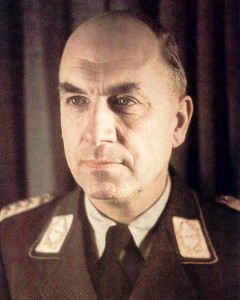Having gained the expert support of Dr. Todt, Bormann would move the Kehlsteinstraße project on with an almost maniacal zeal. Within months of his initial discussion with Todt the first blueprints were already being produced, and by the end of 1936 over nine-hundred acres of additional land had been purchased from the Bayerische Staatsforstverwaltung (Bavarian State Forestry Administration) at a cost of 800,000 RM (approximately €2.8 million, $4 million or £2.5 million today).
While the project remained under the auspices of Dr. Todt, the initial plans for the development were submitted by state engineer August Michahelles – who as an outsider quickly found himself easily manipulated by project manager Bormann. Having been informed that Hitler had wanted to see the road ready by the spring of 1938, Michahelles felt obliged to pull out all the stops – completely unaware of the fact that the Führer knew nothing of the Reichsleiter’s plans.
By the turn of the year Michahelles’ initial plans had been approved by Dr. Todt, and by January 1937 the first construction gangs were making their way to the Obersalzberg. The severe winter weather would be of no great concern to Bormann however, and by the middle of the month construction would begin in earnest – and, as it turned out, in haste.
The Planning Begins
Two companies had been engaged to begin construction on the road, Sager & Woerner of Munich and the Frankfurt-based firm of Polensky & Zöllner. Construction commenced on 18th January, but was quickly called to a halt when problems with the foundations were discovered in March. The following month Dr. Todt created the Staatliche Bauleitung Obersalzberg (“State Construction Management Obersalzberg”), with the Austrian Hans Haupner being appointed as Chief State Engineer.
Less than a fortnight after the creation of the new office Bormann, along with Dr. Todt and the engineers Haupner and Michahelles, carried out a more thorough inspection of the area. All of the engineers had been prepared to work around the problems that had developed during the first construction attempt, only for the unpredictable Bormann to alter the plan. The Reichsleiter had initially wanted to have the route traverse the northern side of the mountain – connecting his home at the 1274-metre Untere Kehlalm cottage with the 1630-metre Obere Kehlalm – but then changed his mind, opting for a route that traversed the Kehlstein’s southern face.
Two alternatives were presented by Chief State Engineer Haupner on 12th April 1937. While the first route took a wider circuit before cutting back inside and looping five times between the 1353-metre Terzangerl and the 1650-metre Sappenkreuz, the second would traverse slightly higher up the mountain, following what would later be called the Giggenbachrieße from Terzangerl through to Schützenköpfl (1556m) before taking a single sharp switchback loop back towards the Sappenkreuz. ![]()
![]() Did You Know?The Giggenbachrieße was named after Bormann's driver, who was killed in a motor accident in the area.
Did You Know?The Giggenbachrieße was named after Bormann's driver, who was killed in a motor accident in the area.
The engineers mulled over the plans for just two days before deciding on the second alternative, which offered a better selection of views of the valley below. By this time, Bormann had started to consider the possibility of building a permanent structure on the summit, which would in turn lead to yet more discussions between the increasingly demanding project manager and the engineers.


